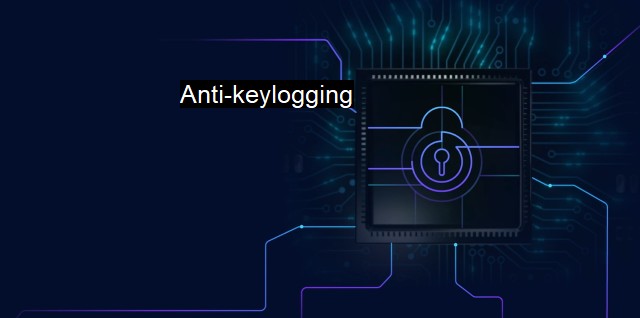What is Anti-keylogging?
Securing Your Keystrokes: Protecting Against Keyloggers with Anti-Keylogging Cybersecurity Software
Anti-keylogging is an essential component in the realm of cybersecurity. Cyberspace is fraught with myriad risks and potential pitfalls, and these dynamic vulnerabilities emphasize the importance of guarding against cyber threats at all levels. One of the most insidious yet overlooked forms of cyber-attacks is keylogging. Understanding what anti-keylogging is, its significance, and how it works forms the basis for implementing robust antivirus strategies that can stave off problems before they occur.Keylogging, more commonly known as keystroke logging or keyboard capturing, is a malevolent method that cyber attackers use to monitor and record the keys struck on a keyboard silently. In simple terms, a keylogger is a program that records every keystroke made by a computer user, especially to gain fraudulent access to passwords and other confidential data. It is an effective contingency, especially for hackers looking to collect sensitive data without alerting the software user.
On the flip side, anti-keylogging measures act as the protective armor against keylogging attacks. By definition, anti-keylogging is a technique used in cybersecurity to protect applications and users from the risk of keylogging. An anti-keylogger is software designed to detect and defend against keyloggers on computers as part of a cybersecurity plan.
The importance of anti-keylogging protection in cybersecurity cannot be overstated. Keyloggers can steal personal data, passwords, credit card numbers, and other confidential information. They are notorious for their stealth, often going undetected even by anti-virus programs.
Anti-keylogging software uses several techniques for detecting and circumventing the operations of keyloggers embedded in the system. One common method used by anti-keyloggers is signature-based detection. This process involves searching for patterns of code or activities related to the behavior of known keyloggers to identify their presence on a system. Another method used is known as heuristics-based detection. Herein, the anti-keylogging software learns to identify potential threats based on their operations relative to standard computer procedures, thereby preemptively protecting the system from unknown keylogger threats.
Certain anti-keyloggers use a technique known as sandboxing that creates a secluded environment where it closely observes the suspicious program's behavior, looking for trackings of keylogging. some software tends to employ keystroke encryption, which begins from the moment you touch the keyboard until the input reaches the application you're interacting with, providing another layer of safety.
Besides protecting individual computers from keyloggers, an augmented anti-keylogging measure can safeguard the broader technological infrastructure, including networks and databases. Given that keyloggers can easily spread through networks, this provides crucial security against distributed attacks which aim at accessing sensitive data on a large scale.
a well-rounded approach cannot solely rely on anti-keylogging. Anti-keyloggers must form part of diversified cyber hygiene habit that includes firewalls, intrusion detection systems, VPNs, regular patching, and intensive user training. Continuous monitoring and updating of cybersecurity defences, along with user awareness, will steadfastly keep these threats at bay.
It is vital to realize that any weak points in cybersecurity protocols might provide opportunistic avenues for cyber perpetrators. Therefore, everything from device security to privacy rules to anti-keylogging becomes an integral part of the approach in preventing keyloggers from gaining unauthorized benefits.
To sum up, anti-keylogging embodies a significant attribute in the wide array of methods deployed to safeguard against cyber threats. Effectively mapped out and implemented, it can deter and distract keyloggers from stealing critical information. Hence, understanding the magnitude of cyber threats like keylogging, along with the inclusion of counter-measures like anti-keyloggers in a comprehensive cybersecurity methodology, paves the way to fortifying cyber resale.

Anti-keylogging FAQs
What is anti-keylogging?
Anti-keylogging is a cybersecurity technology that helps prevent keystroke logging or keylogging. It blocks any unauthorized access to a user’s keystrokes by encrypting or masking user inputs, preventing the theft of sensitive information such as login credentials, credit card numbers, and personal data.How does anti-keylogging work?
Anti-keylogging works by detecting and preventing keylogging software from capturing user keystrokes by either encrypting keystrokes within the system or using virtual keyboards to mask keystrokes from keyloggers. Anti-keylogging also tracks and monitors system activity to detect any suspicious behavior that may be associated with keylogging.What are the benefits of using anti-keylogging software?
Using anti-keylogging software can help prevent identity theft and cyber attacks that involve the theft of sensitive information. It can also protect personal data, login credentials, and credit card information from being stolen by keylogging malware. Anti-keylogging software can offer an additional layer of protection alongside antivirus software, making it more difficult for cybercriminals to access a user’s personal information.Is anti-keylogging software necessary if I already have antivirus software?
While antivirus software can detect and remove malware, it may not always be able to detect keylogging software. Anti-keylogging software is specifically designed to protect against keystroke logging, making it a useful addition to antivirus software. It is always recommended to have both antivirus and anti-keylogging software for comprehensive cybersecurity protection.Related Topics
Anti-spyware software Anti-malware software Firewall protection Intrusion detection system Two-factor authentication
| | A | | | B | | | C | | | D | | | E | | | F | | | G | | | H | | | I | | | J | | | K | | | L | | | M | |
| | N | | | O | | | P | | | Q | | | R | | | S | | | T | | | U | | | V | | | W | | | X | | | Y | | | Z | |
| | 1 | | | 2 | | | 3 | | | 4 | | | 7 | | | 8 | | |||||||